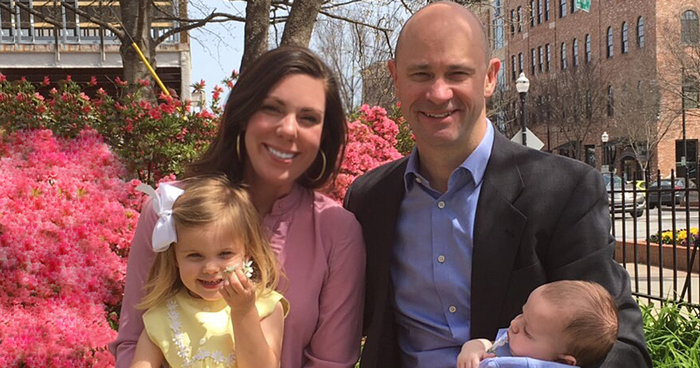
Kelly Gregory and her family.
My husband and I have always been planners. Spreadsheets, calendars, task-monitoring apps—we utilize and love them all. So when we decided we were ready to become parents, we approached that new phase of our lives just as we would anything else—with careful planning.
Once we made it through the all-important first trimester, we began asking friends and co-workers about recommendations for full time child care facilities. After compiling our list of options, I began calling facilities in January 2014, when I was 5 months along in my pregnancy. I would have three months of maternity leave, so as I picked up the phone to call the first facility on our list, I silently patted myself on the back about the fact that I was calling a full 8 months before we would need care.
When I explained to the director with whom I was speaking that we were looking for child care for an infant beginning in August of that year, she explained (with a bit of shock in her voice) that her facility had a multi-year wait list. Much to my dismay, I received the same response phone call after phone call. “We’d be happy to put your name on our waiting list, but I won’t be able to take your baby in August.”
My heartbeat rapidly increased with each click of the receiver. How could we not have known? And what were we going to do?
During a panicked conversation with a friend a few days later, she offered us a glimmer of hope. She knew someone who was building a new child care facility in downtown Greenville, about 15 minutes from where we lived. We knew at this point we had nothing to lose, so we called the number and set up a time to meet with the owner. After meeting with her and reviewing the materials, and once we digested the amount that we were going to have to spend every month, we felt like we had just happened upon the best yet-to-be-discovered secret in Greenville…and we breathed a collective sigh of relief.
When we told the owner that we’d like to enroll our yet-to-be-born infant in her facility, she smiled and said, “I’m so happy you came today! I have one infant spot left, so it’s yours.” With eyes as wide as dinner plates, I said, “You only have one spot left? But your school doesn’t even exist yet?!” Her response? “I know, it’s crazy isn’t it? That’s Greenville for you.”
Turns out, it’s not just Greenville. That was our first glimpse into living in a child care desert, where there is very limited access to affordable, high-quality child care. There are thousands of “child care deserts” across the country — communities that have more than three children for every licensed child care slot.
That has real consequences for families like mine. In the last five years, which have included job changes and the addition of another baby, we have had multiple child care transitions and have even cobbled together options from two different facilities that were next door to each other. For a period of time, my daughter would wake up in the morning and ask, “Am I going to my Wednesday school today or to my other school?” I tell myself that it has made her more flexible than your average 4-year-old.
The most important part of all of this? My husband and I came to this process with many more resources than the majority of parents. We have masters degrees, we are financially secure, and we “knew people who knew people,” and it was still hard for us. As with most things in life, anytime I experience a roadblock to something, one of my first thoughts is, “If this was difficult for someone like me - someone who has everything I could possibly need and then some - what must it be like for someone else who doesn’t come to the table with my same resources?”
The issue of child care is one that crosses many socioeconomic boundaries because, depending on who you are, leaving your child to be cared for by someone else all day every day can be either a necessity or a luxury.
We have to do better for children and families. That’s why I’m heading to Washington, D.C. to participate in Save the Children and Save the Children Action Network’s annual Advocacy Summit. Congress needs to hear stories like mine and help fix this problem. I’ll be going to Capitol Hill to ask my members of Congress to cosponsor the Child Care Workforce and Facilities Act which will start to address the issue of child care deserts.